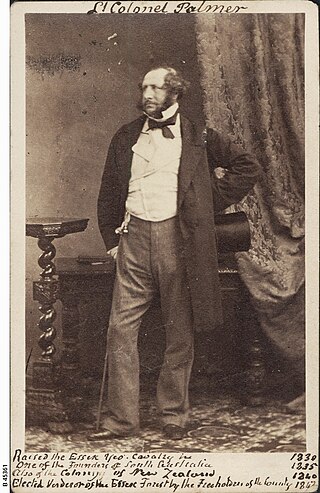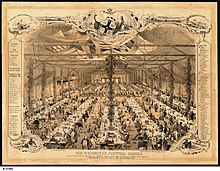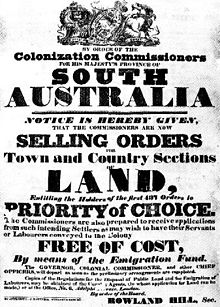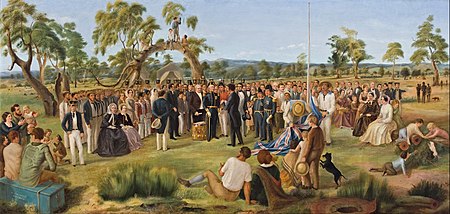
William Light, also known as Colonel Light, was a British-Malayan naval and army officer. He was the first Surveyor-General of the new British Province of South Australia, known for choosing the site of the colony's capital, Adelaide, and for designing the layout of its streets, six city squares, gardens and the figure-eight Adelaide Park Lands, in a plan later sometimes referred to as Light's Vision.

The New Zealand Company, chartered in the United Kingdom, was a company that existed in the first half of the 19th century on a business model that was focused on the systematic colonisation of New Zealand. The company was formed to carry out the principles devised by Edward Gibbon Wakefield, who envisaged the creation of a new-model English society in the Southern Hemisphere. Under Wakefield's model, the colony would attract capitalists, who would then have a ready supply of labour: migrant labourers who could not initially afford to be property owners but would have the expectation of one-day buying land with their savings.

Edward Gibbon Wakefield is considered a key figure in the establishment of the colonies of South Australia and New Zealand. He also had significant interests in British North America, being involved in the drafting of Lord Durham's Report and being a member of the Parliament of the Province of Canada for a short time.
Proclamation Day commonly refers to the anniversary of the proclamation of government of the province of South Australia, which continues to be celebrated in South Australia on 28 December, although no longer a public holiday. The anniversary of the establishment of self-government on 21 October 1890 was formerly known as Proclamation Day in Western Australia.

This article details the history of Adelaide from the first human activity in the region to the 20th century. Adelaide is a planned city founded in 1836 and the capital of South Australia.

Rear-Admiral Sir John Hindmarsh KH was a naval officer and the first Governor of South Australia, from 28 December 1836 to 16 July 1838.

George Fife Angas was an English businessman and banker who, while residing in England, played a significant part in the formation and establishment of the Province of South Australia. He established the South Australian Company and was its founding chairman of the board of directors.

The South Australia Act 1834, or Foundation Act 1834 and also known as the South Australian Colonization Act, was an Act of the Parliament of the United Kingdom which provided for the settlement of a province or multiple provinces on the lands between 132 degrees east and 141 degrees of east longitude, and between the Southern Ocean, and 26 degrees south latitude, including the islands adjacent to the coastline.
The South Australian Company, also referred to as the South Australia Company, was formed in London on 9 October 1835, after the South Australia (Foundation) Act 1834 had established the new British Province of South Australia, with the South Australian Colonization Commission set up to oversee implementation of the Act.

The South Australia Act 1842 is an Act of the Parliament of the United Kingdom, which repealed the South Australia Act 1834, as well as amendments made to that Act, and instituted a different form of Government over the Province of South Australia. The Act was introduced as a result of recommendations by a British parliamentary enquiry into the failure of the colonial administration which had brought the province of South Australia near bankruptcy in 1840, and gave the British Government full control of South Australia as a Crown Colony. The Act was passed on 30 July 1842.
The Letters Patent establishing the Province of South Australia, dated 19 February 1836 and formally titled "Letters Patent under the Great Seal of the United Kingdom erecting and establishing the Province of South Australia and fixing the boundaries thereof", was presented to King William IV to formally seek the approval to establish the Province of South Australia. It defined the boundaries of the new colony, but also, significantly and unlike the South Australia Act 1834, included recognition of the rights of the Aboriginal peoples of South Australia. It is sometimes referred to as Letters Patent 1836.
The history of South Australia includes the history of the Australian state of South Australia since Federation in 1901, and the area's preceding Indigenous and British colonial societies. Aboriginal Australians of various nations or tribes have lived in South Australia for at least thirty thousand years, while British colonists arrived in the 19th century to establish a free colony. The South Australia Act, 1834 created the Province of South Australia, built according to the principles of systematic colonisation, with no convict settlers.

Robert Torrens was a Royal Marines officer, political economist, part-owner of the influential Globe newspaper, and a prolific writer. He also chaired the board of the London-based South Australian Colonisation Commission created by the South Australia Act 1834 to oversee the new colony of South Australia, before the colony went bankrupt and he was sacked in 1841. He was chiefly known for championing the cause for emigration to the new colony, and his name lives on in Adelaide's main river, the Torrens, the suburb of Torrensville and a few other places.

Adelaide city centre is the inner city locality of Greater Adelaide, the capital city of South Australia. It is known by locals simply as "the City" or "Town" to distinguish it from Greater Adelaide and from the City of Adelaide local government area. The population was 15,115 in the 2016 census.

Sir James Hurtle Fisher was a lawyer and prominent South Australian pioneer. He was the first Resident Commissioner of the colony of South Australia, the first Mayor of Adelaide and the first resident South Australian to be knighted.

Robert Gouger was one of the founders of South Australia and the first Colonial Secretary of South Australia.

Henry Inman (1816–1895) was an English cavalry officer, pioneer of South Australia, founder and first commander of the South Australia Police, overlander and Anglican clergyman.
The South Australian Literary and Scientific Association, formerly the South Australian Literary Association and also known as the South Australian Literary Society, was active in London before the British colonisation of South Australia after its establishment on 29 August 1834. The Association played a part in the foundation of the South Australian Museum, the State Library of South Australia and the Royal Society of South Australia.
Jacob Barrow Montefiore (1801–1895) was a member of the South Australian Colonization Commission in London from 1835 to 1839, a body appointed by the British Government under King William IV to oversee implementation of the South Australia Act 1834, which established the Colony of South Australia.

George Palmer, also referred to as George Palmer Jnr, was a lieutenant colonel in the Essex Yeomanry, and one of the South Australian Colonisation Commissioners appointed on 5 May 1835.



















